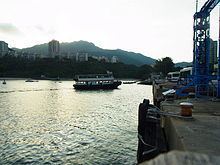 | ||
Nim Shue Wan (Chinese: 稔樹灣) is the south facing bay on the south side of Discovery Bay, Lantau Island, Hong Kong. Nim Shue Wan village was a small fishing village but now has become a dormitory village for workers at nearby Discovery Bay.
Contents
Map of Nim Shue Wan, Hong Kong
Boats and piers
The bay provides a safe anchorage for small fishing boats and pleasure craft. An even safer haven is provided by the Discovery Bay Marina Club which has a well established marina, now occupied by a large number of live-aboard residents who rarely set sail from their berths.
The jetty pier at Nim Shue Wan was once the main freight pier serving Discovery Bay before the Discovery Bay road tunnel linking to the Lantau Link opened in 2000. The pier has a vehicular ferry ramp and until 2006 also had building waste discharge ramps. There is also a marine refuelling bowser for commercial and public customers.
Today the pier is still the main passenger kai-to (small ferry) pick up point for services to neighbouring islands and other locations on Lantau.
History
Sources indicate that Nim Shue Wan Village was a small Hakka village in the 19th century, that became deserted towards the end of the century, after it was destroyed by a typhoon that was followed by a disease. In the 1950s, James W. Hayes reported that Nim Shue Wan Village, once a prosperous village, had been uninhabited for 20–30 years until it was settled again by Hakka newcomers in the 1940s. These - at the time - recent inhabitants were farming vegetables and breeding pigs. In 1961, the village population reached about 200 people of 52 families in 1961. It later grew to 500 people.
Temple
There is a Tin Hau Temple in Nim Shue Wan, which was built in 1920. Villagers moved the statue of the goddess to Peng Chau during the Japanese occupation of Hong Kong. The temple was rebuilt in 1972 and in 2003.
